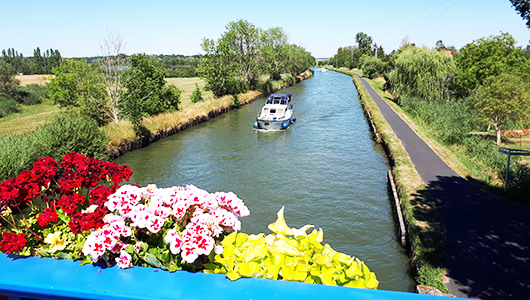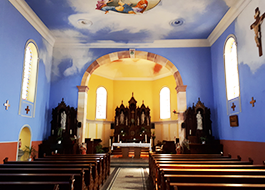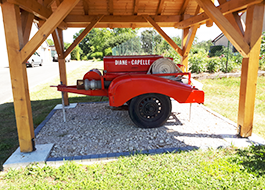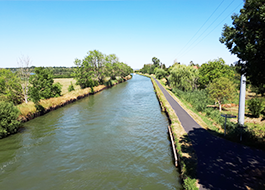Diane-Capelle
Durée visite : 70 minutes
Moyen : Pédestre
D’abord appelé Capelle, le village reçut son second nom de sa bienfaitrice, qui l’avait reconstruit. Diane de Fénétrange-Dommartin vécut entre 1552 et1625. Issue d’une vieille famille de la chevalerie lorraine, elle épousa le Rhingrave Jean-Philippe de Salm, tué au combat par l’amiral de Coligny en 1569, puis Charles de Croÿ- Havré, chef du parti catholique aux Pays-Bas. Elle est la lointaine ancêtre d’Eugénie de Montijo, épouse de Napoléon III. Le village appartint au bailliage d’Allemagne, terres germanophones du duché de Lorraine. Il passa entre 1751 et 1789 à celui de Fénétrange, en Lorraine désormais française.
First called Capelle, the village received its second name from its benefactress, who had rebuilt it. Diane de Fénétrange-Dommartin lived between 1552 and 1625. Coming from an old family of the Lorraine chivalry, she married the Rhingrave Jean-Philippe de Salm, killed in action by Admiral de Coligny in 1569, then Charles de Croÿ-Havré, leader of the Catholic party in the Netherlands. She is the distant ancestor of Eugénie de Montijo, wife of Napoleon III. The village belonged to the Bailiwick of Germany, German-speaking lands of the Duchy of Lorraine. He passed between 1751 and 1789 to that of Fénétrange, in Lorraine now French.
Das Dorf hieß zuerst Capelle und erhielt seinen zweiten Namen von seiner Wohltäterin, die es wieder aufgebaut hatte. Diane de Fénétrange-Dommartin lebte zwischen 1552 und 1625. Sie stammte aus einer alten Familie der lothringischen Ritterlichkeit und heiratete den Rhingrave Jean-Philippe de Salm, der 1569 von Admiral de Coligny und Charles de Cro Charles-Havré, dem Führer der katholischen Partei in den Niederlanden, getötet wurde. Sie ist die entfernte Vorfahrin von Eugénie de Montijo, der Frau Napoleons III. Das Dorf gehörte zur Vogtei Deutschlands, dem deutschsprachigen Raum des Herzogtums Lothringen. Er ging zwischen 1751 und 1789 zu dem von Fénétrange in Lothringen über, das jetzt Französisch ist.

De sinople au croissant d’argent soutenant une chapelle du même, au chapé ployé d’argent à trois fasces de gueules.
Le village, reconstruit au début du XVIIe siècle, a reçu son nom en l’honneur de Diane de Croÿ. Aux fasces des Croÿ, on a ajouté des emblèmes parlants, une chapelle et le croissant de Diane.
Vert to the crescent Argent supporting a chapel of the same, to the folded chape Argent with three fess Gules.
The village, rebuilt at the beginning of the 17th century, received its name in honor of Diane de Croÿ. Speaking emblems, a chapel and the crescent of Diana have been added to the Croÿ fasces.
Vert zum sichelförmigen Argent, der eine Kapelle desselben trägt, zum gefalteten Chape Argent mit drei Fess Gules. Das zu Beginn des 17. Jahrhunderts wiederaufgebaute Dorf erhielt seinen Namen zu Ehren von Diane de Croÿ. Den Croÿ-Faszen wurden Embleme, eine Kapelle und der Halbmond von Diana hinzugefügt.
Les points de visites
.
A l’entrée, une stèle rappelle les victimes de 14-18. L’église date de 1715. Sa nef vous accueille avec son superbe bleu céleste. Il est rehaussé par la belle lumière des vitraux, dont les plus récents sont dus aux ateliers Benoît, de Saint-Nicolas-de-Port. Vous ne pouvez manquer le magnifique autel avec reliquaire. L’orgue de 1913 est signé Dalstein-Haerpfer de Boulay. La manufacture, fondée en 1863, livra plus de 160 instruments, principalement dans le Reichsland Elsaß-Lothringen, en raison des barrières douanières élevées avec la France. Dalstein et Haerpfer étaient les facteurs d’orgue favoris d’Albert Schweitzer. La paroisse était rattachée à Kerprich. Mais les fidèles refusaient de payer les redevances au curé de ce village. On les sépara en 1729, puis on les réunit à nouveau de 1802 à 1846. A cette date, il y eut un curé à Diane-Capelle. A noter que les deux communes furent réunies de 1972 à 1985. Puis de nouveau séparées. Bis repetita.
At the entrance, a stele recalls the victims of 14-18. The church dates from 1715. Its nave welcomes you with its superb celestial blue. It is enhanced by the beautiful light of the stained glass windows, the most recent of which are due to the Benoît workshops in Saint-Nicolas-de-Port. You cannot miss the magnificent altar with reliquary. The 1913 organ is signed Dalstein-Haerpfer de Boulay. The manufactory, founded in 1863, delivered more than 160 instruments, mainly to the Reichsland Elsaß-Lothringen, due to the high customs barriers with France. Dalstein and Haerpfer were Albert Schweitzer’s favorite organ builders.
The parish was attached to Kerprich. But the faithful refused to pay the royalties to the parish priest of this village. They were separated in 1729, then they were reunited again from 1802 to 1846. On that date, there was a parish priest at Diane-Capelle. Note that the two municipalities were reunited from 1972 to 1985. Then again separated. Bis repetita.
Am Eingang erinnert eine Stele an die Opfer von 14-18 Jahren. Die Kirche stammt aus dem Jahr 1715. Das Kirchenschiff empfängt Sie mit seinem prächtigen himmlischen Blau. Es wird durch das schöne Licht der Buntglasfenster verstärkt, von denen die jüngsten auf die Benoît-Werkstätten in Saint-Nicolas-de-Port zurückzuführen sind. Sie können den prächtigen Altar mit Reliquiar nicht verfehlen. Die Orgel von 1913 ist mit Dalstein-Haerpfer de Boulay signiert. Die 1863 gegründete Manufaktur lieferte aufgrund der hohen Zollschranken mit Frankreich mehr als 160 Instrumente, hauptsächlich an das Reichsland Elsaß-Lothringen. Dalstein und Haerpfer waren Albert Schweitzers Lieblingsorgelbauer.
Die Gemeinde war an Kerprich angeschlossen. Aber die Gläubigen weigerten sich, dem Pfarrer dieses Dorfes die Lizenzgebühren zu zahlen. Sie wurden 1729 getrennt und von 1802 bis 1846 wieder vereint. Zu diesem Zeitpunkt gab es in Diane-Capelle einen Pfarrer. Beachten Sie, dass die beiden Gemeinden von 1972 bis 1985 wiedervereinigt wurden. Dann wieder getrennt. Bis repetita.
.
.
Dans la lutte contre l’incendie, la motopompe est surtout utilisée en milieu rural. L’approvisionnement en eau y est difficile. De plus les sinistres en requièrent de grandes quantités. La motopompe est constituée d’une pompe centrifuge hydraulique. Cette dernière est couplée à un moteur à explosion. Elle est donc entièrement autonome.
In the fight against fire, the motor pump is mainly used in rural areas. Water supply is difficult there. In addition, claims require large quantities. The motor pump consists of a hydraulic centrifugal pump. The latter is coupled to an internal combustion engine. It is therefore entirely autonomous.
Im Kampf gegen Feuer wird die Motorpumpe hauptsächlich in ländlichen Gebieten eingesetzt. Die Wasserversorgung ist dort schwierig. Darüber hinaus erfordern Ansprüche große Mengen. Die Motorpumpe besteht aus einer hydraulischen Kreiselpumpe. Letzterer ist mit einem Verbrennungsmotor gekoppelt. Es ist daher völlig autonom.
.
Cet ancien engin agricole est une moissonneuse-botteleuse. Datant de la fin du XIXe siècle, elle fonctionnait à la vapeur. Le foin ou la paille étaient mis en bottes. On amenait les herbes coupées à la machine. Celle-ci stationnait soit prés du champ, soit prés de la ferme. Des petites roues permettaient de la mouvoir et de la rentrer dans la grange, le travail terminé. Les quantités traitées étaient faibles par rapport aux rendements actuels. Les machines sont d’ailleurs devenues monstrueuses. La mise en bottes se fait en même temps que la moisson. Les champs étaient de petite taille, avant le grand remembrement des années 1960.
This old agricultural machine is a baler. Dating from the end of the 19th century, it worked with steam. Hay or straw were bundled. We brought the cut herbs to the machine. It was stationed either near the field or near the farm. Small wheels allowed it to be moved and returned to the barn, when the job was done. The amounts treated were low compared to current yields. The machines have also become monstrous. The bundling is done at the same time as the harvest. The fields were small, before the great consolidation of the 1960s.
Diese alte landwirtschaftliche Maschine ist eine Ballenpresse. Es stammt aus dem Ende des 19. Jahrhunderts und arbeitete mit Dampf. Heu oder Stroh wurden gebündelt. Wir haben die geschnittenen Kräuter zur Maschine gebracht. Es war entweder in der Nähe des Feldes oder in der Nähe der Farm stationiert. Kleine Räder ermöglichten es, es zu bewegen und in die Scheune zurückzubringen, wenn die Arbeit erledigt war. Die behandelten Mengen waren im Vergleich zu den aktuellen Ausbeuten gering. Die Maschinen sind auch monströs geworden. Die Bündelung erfolgt zeitgleich mit der Ernte. Die Felder waren vor der großen Konsolidierung in den 1960er Jahren klein.
.
La croix de chemin est un symbole religieux catholique. Elle est très répandue du XVIe siècle à nos jours. Ces croix sont dues souvent à lune initiative privée. Une famille aisée souhaitait à la fois affirmer sa foi, protéger les siens, obtenir une faveur. C’est le cas ici. On distingue le nom de la famille commanditaire. Parfois, on y trouvait même un blason.
The Way Cross is a Catholic religious symbol. It is very widespread from the 16th century to the present day. These crosses are often due to private initiative. A well-off family wanted to both assert their faith, protect their own, and obtain a favor. This is the case here.We can distinguish the name of the sponsoring family. Sometimes there was even a coat of arms there.
Das Wegkreuz ist ein katholisches religiöses Symbol. Es ist vom 16. Jahrhundert bis heute sehr verbreitet. Diese Kreuze sind oft auf private Initiative zurückzuführen. Eine wohlhabende Familie wollte sowohl ihren Glauben behaupten als auch ihren eigenen schützen und einen Gefallen erlangen. Dies ist hier der Fall. Wir können den Namen der Patenfamilie unterscheiden. Manchmal gab es dort sogar ein Wappen.
.
Le canal des houillères de la Sarre fut creusé entre 1861 et 1866. Il traverse le Nord-Est de la Lorraine et borde l’Alsace Bossue à lOuest. L’existence du gisement houiller de Sarrebruck et de l’industrie de Mulhouse, grosse demandeuse de charbon, éloignés l’un de l’autre furent à l’origine de la création de cette voie. Les aciéries de la Sarre, ainsi que les faïenceries de Sarreguemines et de Mettlach (Villeroy et Boch) l’utilisèrent pour leurs livraisons de masse et lointaines, telles que Paris ou le port de Marseille. La canalisation au gabarit Freycinet s’arrêta à Mettlach, sans débouché aval vers la Moselle. La canalisation depuis Trêves fut réalisée dans les années 1980, au grand gabarit rhénan, mais à partir de Sarrebruck seulement. Le canal et la Sarre canalisée forment une voie d’eau de 105 km, dont 63 km de canal artificiel comprenant 27 écluses.
The Saar coal channel was dug between 1861 and 1866. It crosses the north-east of Lorraine and borders Alsace Bossue to the west. The existence of the coal deposit of Saarbrücken and the industry of Mulhouse, a large demand for coal, distant from each other were at the origin of the creation of this route. The steelworks of the Saar, as well as the earthenware factories of Sarreguemines and Mettlach (Villeroy and Boch) used it for their mass and distant deliveries, such as Paris or the port of Marseille. The Freycinet-gauge pipeline stopped at Mettlach, with no outlet downstream to the Moselle. The pipeline from Treves was carried out in the 1980s, at the Rhine large gauge, but from Saarbrücken only. The canal and the canalized Saarland form a 105 km waterway, of which 63 km is an artificial canal comprising 27 locks.
Der Saarer Kohlekanal wurde zwischen 1861 und 1866 gegraben. Er durchquert den Nordosten Lothringens und grenzt im Westen an das Elsass-Bossue. Die Existenz des Kohlevorkommens von Saarbrücken und der Industrie von Mulhouse, eine große Nachfrage nach Kohle, die weit voneinander entfernt waren, waren der Ursprung der Schaffung dieser Route. Das Stahlwerk der Saar sowie die Steingutfabriken von Sarreguemines und Mettlach (Villeroy und Boch) nutzten es für ihre Massen- und Fernlieferungen wie Paris oder den Hafen von Marseille. Die Freycinet-Pipeline hielt in Mettlach an und hatte keinen Abfluss stromabwärts zur Mosel. Die Pipeline von Treves wurde in den 1980er Jahren am Rhein-Großspur durchgeführt, jedoch nur von Saarbrücken. Der Kanal und das kanalisierte Saarland bilden eine 105 km lange Wasserstraße, von denen 63 km ein künstlicher Kanal mit 27 Schleusen sind.










